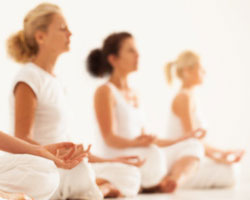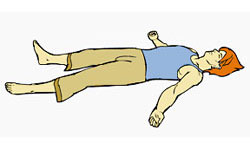Yoga and Hypertension
 Uncontrolled hypertension, is undoubtedly, a major threat to public health worldwide based upon the amount of evidence available. Likewise, there is an abundant amount of evidence-based knowledge available on how to prevent this costly disease. Yet there has been a widely acknowledged failure achieving adequate prevention and treatment in our society. There are many contributing factors explaining this failure. One obstacle in the prevention of hypertension is that it is a disease that typically has few, if any, symptoms. An obstacle in the treatment of hypertension is patient adherence.
Uncontrolled hypertension, is undoubtedly, a major threat to public health worldwide based upon the amount of evidence available. Likewise, there is an abundant amount of evidence-based knowledge available on how to prevent this costly disease. Yet there has been a widely acknowledged failure achieving adequate prevention and treatment in our society. There are many contributing factors explaining this failure. One obstacle in the prevention of hypertension is that it is a disease that typically has few, if any, symptoms. An obstacle in the treatment of hypertension is patient adherence.
The opinions of public health experts have shown that blood pressure is the most important cause of death and disability in the world. Elevated blood pressure is responsible for 62 percent of all strokes and 49 percent of all heart disease. Hypertension is the most prevalent preventable disease affecting 20 to 50 percent of the adult population in developed countries. By 2025, almost 75 percent of the worldwide population with hypertension will be in developing countries1.
Improving outcomes will depend on building an effective balance between reducing risk factors by prescribing appropriate medication at the right time, working with patients to improve their adherence to treatment and incorporating beneficial lifestyle changes. We will discuss the practice of Yoga as one beneficial lifestyle change that may be utilized in the prevention and treatment of hypertension.
Yoga
 The word Yoga means to join or yoke together. The techniques of Yoga are believed to bring the body and mind together into one harmonious experience through the practice of exercise, breathing and meditation. It is believed that the desire for a better quality of life over 5,000 years ago gave birth to this system of physical and mental exercises which has since spread throughout the world. The exercises of Yoga are designed to improve the efficiency of the various organs systems within the body which, in turn, results in optimal health.
The word Yoga means to join or yoke together. The techniques of Yoga are believed to bring the body and mind together into one harmonious experience through the practice of exercise, breathing and meditation. It is believed that the desire for a better quality of life over 5,000 years ago gave birth to this system of physical and mental exercises which has since spread throughout the world. The exercises of Yoga are designed to improve the efficiency of the various organs systems within the body which, in turn, results in optimal health.
The breathing techniques of Yoga aim to gently increase the control of breathing which may lead to an improvement of the health and function of both the body and mind. Along with exercise, breathing prepares the body and mind for meditation. Meditation allows one to quiet their mind which is thought to allow healing from everyday stress. The daily practice of all three aspects of Yoga produce a better mind and body.
There are over a hundred different schools of Yoga with many of them following the eight steps of classical Yoga. The eight steps involved with classical Yoga are as followed; restraint, observance, physical exercises, breathing techniques, preparation for meditation, concentration, meditation and absorption. For this discussion, we will discuss Yoga's possible impact upon the prevention and treatment of hypertension and will consider individual techniques from all schools as a whole.
Yoga impacting blood pressure
There have been various studies conducted which investigated Yoga's impact on the human body and health. A thorough review of the available studies and their results as a whole concluded that Yoga has a significant effect on lowering blood pressure. For example, researchers at Kennesaw State University performed an integrative review of Yoga therapy reducing blood pressure in patients with hypertension. They found that Yoga works because it modulates the cardiovascular system and its effect on the heart rate2.
More specifically, researchers at the University of Maryland conducted a similar review and reported a growing body of evidence that supports the belief that Yoga benefits physical and mental health via the down-regulation of the hypothalamic-pituitary-adrenal axis (HPA) and the sympathetic nervous system (SNS)3,4.
The HPA involves the interactions and feedback among three specific endocrine organs; the hypothalamus, pituitary gland and the adrenal glands. These organs control reactions to stress and regulates many body processes in response to stress. The body's response to stress is also regulated by the autonomic nervous system (ANS).
The SNS is apart of the ANS that controls automated body functions including heart rate, blood pressure, digestion, and metabolism. The ANS is subdivided into the parasympathetic and sympathetic components that work antagonistically to provide a very fine degree of control over their target, in particular the cardiovascular system5.
The SNS is also known as the flight-or-fight system. Its activation prepares an individual to react to potential threats upon one's health. The repetitive activation of the SNS is associated with specific and potentially detrimental changes to the body. Together, the HPA and SNS are believed to play a significant role in the development of hypertension.
5 Yoga poses to utilize to treat and prevent hypertension
 The easy pose is a relaxation pose intended for meditation. First, sit down on the floor or mat. Close your legs and place your feet below your knees. Clasp your hands around your knees. Finally, keep your head and body straight.
The easy pose is a relaxation pose intended for meditation. First, sit down on the floor or mat. Close your legs and place your feet below your knees. Clasp your hands around your knees. Finally, keep your head and body straight.
The bridge pose is effective in promoting relaxation and reducing stress. Lie on your back with your knees bent, feet together. Keep your arms at your sides and palms on the floor. Lift the hips towards the ceiling, keeping your feet and palms flat on the floor. Maintain your position and move your arms over your head.

The child pose helps relieve stress and fatigue. Kneel down and sit on your feet with your heels pointing outward. Separate your knees to about the width of your hips. Next, place your forehead on the floor and then swing your arms forward. Finally, rest your forehead on the floor and bring your arms around to your sides, palms facing upward.

The fish pose expands the rib cage fully, increasing your lung capacity and aids in deep breathing. Lie down on your back with your legs straight and your feet together. Place your hands with palms facing down, underneath your thighs. Press down on your elbows, inhale and arch your back. Next, drop your head back so that the top of your head is on the floor. Your weight should be shifted on your elbows. Breathe deeply and slowly while in the position, keeping your legs and lower torso relaxed. Finally, lift your head and place it gently back down, then release the arms to come out of the pose.

 The corpse pose will stimulate blood circulation and will lessen or relieve fatigue and nervousness and improve mental concentration. Start by rotating your legs in and out and let them fall gently out to the sides. Let your arms fall alongside your body. Your arms should be slightly separated from the body with the palms facing upwards. Rotate the spine by turning your head from side to side to center it. Start stretching yourself out, as though someone is pulling your head away from your feet, your shoulders down and away from your neck, your legs down and away from your pelvis. Breathe deeply and slowly from your abdomen. Hold the pose for several minutes. Make your mind still and concentrate on your breath or the body. After doing the pose, bend your knees. Using your legs, push yourself onto one side and push yourself in a sitting position.
The corpse pose will stimulate blood circulation and will lessen or relieve fatigue and nervousness and improve mental concentration. Start by rotating your legs in and out and let them fall gently out to the sides. Let your arms fall alongside your body. Your arms should be slightly separated from the body with the palms facing upwards. Rotate the spine by turning your head from side to side to center it. Start stretching yourself out, as though someone is pulling your head away from your feet, your shoulders down and away from your neck, your legs down and away from your pelvis. Breathe deeply and slowly from your abdomen. Hold the pose for several minutes. Make your mind still and concentrate on your breath or the body. After doing the pose, bend your knees. Using your legs, push yourself onto one side and push yourself in a sitting position.
In conclusion, one way to prevent and treat hypertension is to incorporate beneficial lifestyle choices. Yoga has been shown in several studies to be an effective option in the treatment of hypertension and thus may be utilized in its prevention. Yoga has been found to positively affect the hypothalamus-pituitary-adrenal axis (HPA) and the sympathetic nervous system (SNS) which have been implicated as major contributors to cause of hypertension. The easy, bridge, child, fish and corpse poses discussed previously may be utilized as an easy to adhere to starting regimen for the prevention or treatment of hypertension.
References:
- Redwood H. Hypertension, society, and public policy. Eur Heart J Suppl (May 2007) 9 (suppl B): B13-B18.
- Okonta NR. Does yoga therapy reduce blood pressure in patients with hypertension?: an integrative review. Holist Nurs Pract. 2012 May-Jun; 26(3): 137-41.
- Ross A, Thomas S. The health benefits of yoga and exercise: a review of comparison studies. J Altern Complement Med. 2010 Jan; 16(1): 3-12.
- Tyagi A, Cohen M. Yoga and hypertension: a systematic review. Altern Ther Health Med. 2014 Mar-Apr; 20(2): 32-59.
- Guyenet PG. The sympathetic control of blood pressure. Nature Reviews Neuroscience. 2006 May; (7): 335-346.









